
The Democratic People's Republic of Korea (DPRK) claims to have conducted test launches of a "new type long-range cruise missile" (Figure 1) on 11 and 12 September 2021. According to DPRK State media, the missiles flew 1,500 km before hitting their targets. This is the first known missile test launch since 25 March 2021 when the DPRK launched two short range ballistic missiles. Based on publicly released information, this briefing offers a preliminary analysis of this new type of cruise missile.
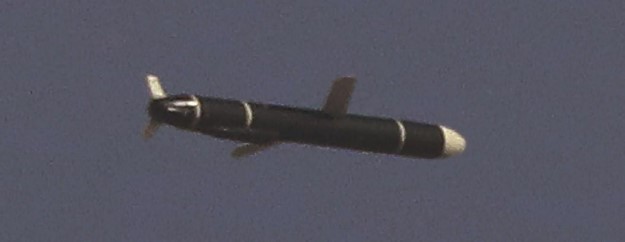
Figure 1. Inflight photo of "new type long-range cruise missile" of the DPRK. Image: Rodong Sinmun
The DPRK's Cruise Missile Capabilities
Given the range and flight time attributed by DPRK State media to the missiles tested on 11 and 12 September 2021, and the pictures published by it, the new missiles appear to be subsonic cruise missiles.
Subsonic cruise missiles are used to attack targets at sea (vessels) or on land. Modern subsonic cruise missiles resemble small planes, as they rely on wings for lift and an air-breathing engine [1] to produce thrust. Advanced land-attack cruise missiles may stealthily penetrate air defence systems by flying below the radars' line of sight and flying an evasive path that was pre-determined by mission planners.
Key challenges in the design and production of subsonic cruise missiles lie in the manufacturing of an air-breathing engine and a guidance system that can provide accuracy over a long range. [2]
However, with the commercialization of guidance kits, receivers of satellite positioning systems and proliferation of other technologies, subsonic cruise missiles are becoming more accessible to State and nonState actors. As a result, subsonic cruise missiles are no longer monopolized by a few militarily highly advanced States. For example, Iran, Pakistan, Taiwan, South Korea and India have developed and deployed their own subsonic cruise missiles.
The DPRK is known to have been operating subsonic anti-ship cruise missiles that originated from the Soviet Union for decades. The DPRK has also developed its own relatively modern subsonic anti-ship cruise missiles.
Figure 2 shows the cruise missiles of the DPRK before the most recent launches.
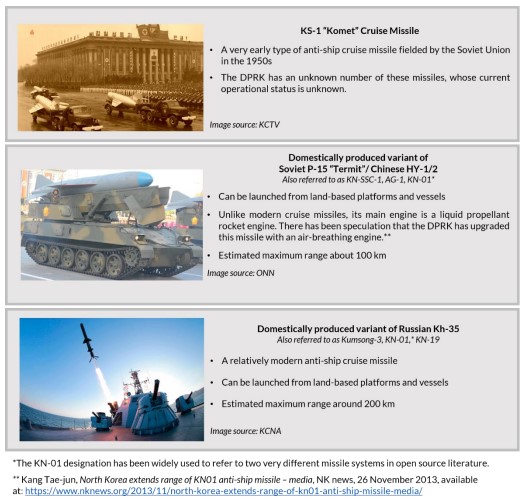
Figure 2. The DPRK's cruise missiles
The DPRK has also developed a rudimentary mid-sized suicide drone that is powered by a small air-breathing engine (Figure 3). In principle, such a drone could also be categorized as a cruise missile. [3] To summarize, the DPRK has developed and accumulated technical capabilities in designing and manufacturing cruise missiles and their subsystems, which could facilitate the indigineous development of a modern cruise missile (Figure 4) with a range of 1,500 km.
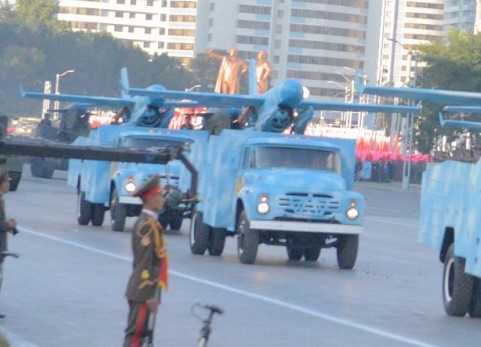
Figure 3. Mid-sized drones during a military parade on 10 October 2015 in Pyongyang. Image: ONN
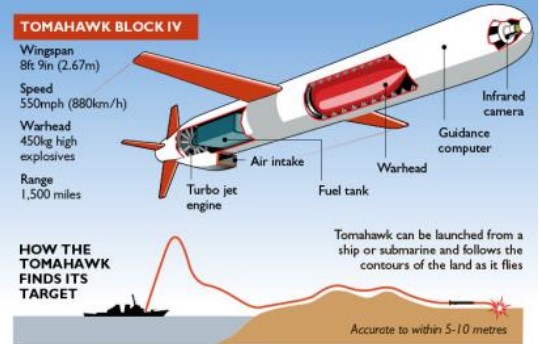
Figure 4. A simplified diagram of a modern subsonic cruise missile. Image: The Times [4]
Analysis of the New Cruise Missile
Judging from the two images released by DPRK State media, the "new type long-range cruise missile" is designed as a typical landattack cruise missile optimized for subsonic cruising. It has two long, swept wings to generate enough lift to sustain the flight altitude during the cruise, and a visible air intake to provide inflow for an air-breathing engine. [5] The missile is launched by a solid propellant booster, which accelerates the missile to a speed where the thrust of the air-breathing engine alone is able to sustain the flight (Figure 5).
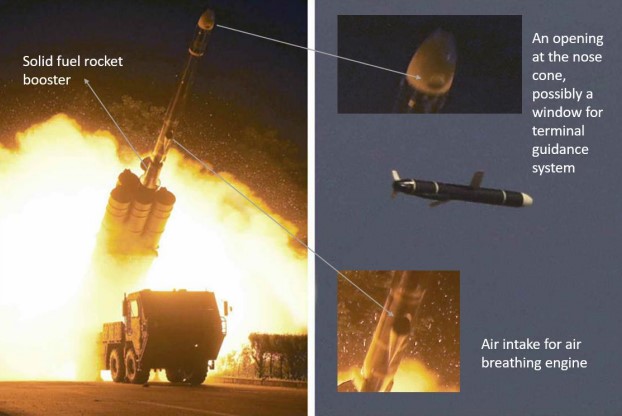
Figure 5. Features of the new cruise missile. Image: Rodong Sinmun
DPRK State media claimed that the "longrange cruise missiles flew 7,580 seconds along the elliptical and 8-shaped flight trajectories" over DPRK territorial land and water, and "hit the target after flying 1,500 km". [6] This would suggest that the cruise missile had an average speed of roughly 200 m/s, or 0.59 Mach [7]. This average speed is lower than the stated speed of other similar cruise missiles, [8] indicating that the DPRK missile may have a less powerful engine. The claimed testing method of flying with an 8-shaped flight path is normal for entities with limited air space for testing. For example, Taiwan, China, has reportedly tested cruise missiles in a similar fashion. [9]
For the majority of its flight, a typical cruise missile relies on an autopilot [10] that is periodically corrected by an onboard satellite positioning system receiver. [11] The DPRK may not have access to highly accurate militarygrade coordinates broadcast by foreign satellite positioning systems. However, the DPRK may have tried to use commercially available satellite positioning system receivers.
At the nose cone of the new cruise missile there appears to be an opening (or a small window), which suggests that it is fitted with an optical terminal guidance system, as claimed by DPRK State media. [12] This system is meant to increase the accuracy of the missile and would only be initiated when the missile has finished the majority of its flight.
Cruise missiles with a 1,500 km range could potentially be used to attack moving targets such as vessels. However, given that the DPRK is yet to demonstrate an ability to reliably monitor moving targets at sea or on the ground at long distance, it is reasonable to conclude that the new DPRK cruise missile is probably a dedicated land-attack weapon for stationary targets (Figure 6).
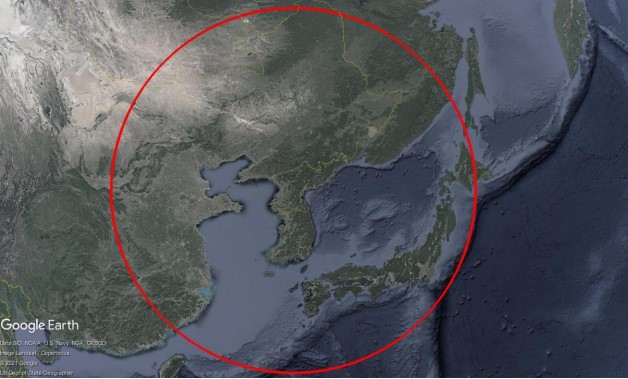
Figure 6. The stated range of 1,500 km could cover all of Japan and the Republic of Korea, as well as parts of China, Mongolia and Russia. Image: Google Earth
DPRK State media have used the term "strategic weapon" to refer to this cruise missile. [13] During the Eighth Party Congress of the Workers' Party of Korea held in January 2021, DPRK leader Kim Jong Un reportedly praised the development of the "ultra-modern tactical nuclear weapons including new-type tactical rockets and intermediate-range cruise missiles whose conventional warheads are the most powerful in the world." [14] After six nuclear tests, the DPRK’s miniaturization of a nuclear device is also thought to have reached a "significant level". [15] However, there is no authoritative information as to whether the country has miniaturized a nuclear warhead to be fitted onto a cruise missile.
DPRK State media also claimed that the DPRK's Academy of Defence Science had carried out multiple tests, including "detailed tests of missile parts, scores of engine ground thrust tests, various flight tests, control and guidance tests, warhead power tests," before the test launches on 11 and 12 September. It is uncertain whether government intelligence bodies were aware of any of these activities. The Joint Chief of Staff of the Republic of Korea (ROK) does not regularly inform the press of non-ballistic missile launches of the DPRK. However, a source inside the ROK government was quoted by JoongAng Ilbo as saying that "the South Korean and US military authorities and intelligence agencies learned about the missile launch after seeing North Korean state media … we failed in advance detection and even afterwards." [16] On 14 September, ROK Defense Minister Suh Wook said that the launches had been detected and an initial analysis was still underway. [17]
As of the date of this analysis, the following cruise missile launches under Kim Jong Un's leadership have been reported publicly (Figure 7).
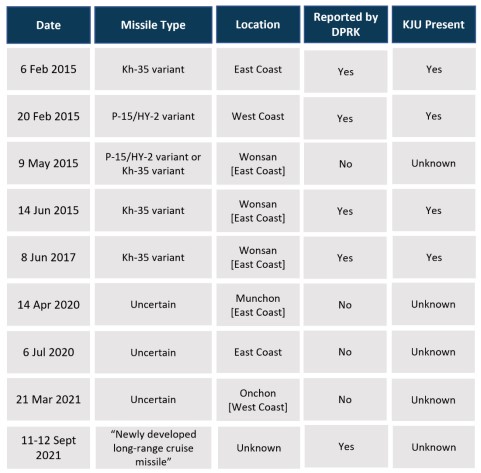
Figure 7. DPRK cruise missile tests under Kim Jong Un's leadership
Given the claim by DPRK State media that the development of this long-range cruise missile has been pursued over the past two years, it is possible that the three cruise missile launches carried out in April 2020, July 2020 and March 2021 were related to the development of this new cruise missile.
Finally, it is worth noting that, during the 10 October 2020 military parade, two weapon systems were showcased. One was a four-axle truck carrying the "super-large caliber" multiple rocket launcher (MRL). [18] The other was a three-axle truck with a two-axle trailer carrying four long tubes thought to be models of long-range cruise missiles. [19]
However, photos of the launches on 11 and 12 September 2021 show that the launcher vehicle for the new long-range cruise missile seems to be the vehicle of the purported MRL.
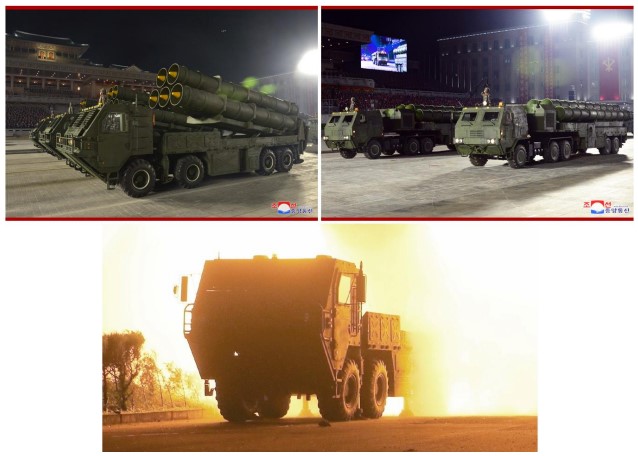
Figure 8. Though partially blurred by exhaust and smoke, the launch vehicle for the new long-range cruise missile (bottom, the photo has been flipped for better comparison) looks similar to the purported multiple launcher vehicle (top left) showcased in the 10 October 2020 parade and is different from the purported long-range cruise missile launcher (top right) showcased in the same parade. Images: KCNA
Conclusion
After decades of operating and developing shorter-range subsonic cruise missiles, and with the proliferation of technologies and commercialization of subsystems, it is possible that the DPRK has become capable of developing a cruise missile with a range in excess of 1,000 km.
Available information is insufficient to determine how sophisticated the DPRK's new long-range cruise missile is. [20] Such a missile is possibly dedicated to attack stationary targets and might be nuclear capable.
This new long-range cruise missile, once deployed, would enhance the DPRK's regional strategic strike capabilities. A combination of ballistic and cruise missiles would pose a greater challenge to the air and missile defence of the US, the ROK and Japan.
Attachment
Long-range Cruise Missiles Newly Developed by Academy of Defence Science Successfully Testfired
Pyongyang, September 13 (KCNA) -- The Academy of Defence Science of the DPRK successfully testfired new type long-range cruise missiles on September 11 and 12.
Pak Jong Chon, member of the Presidium of the Political Bureau and secretary of the Central Committee of the Workers' Party of Korea, watched the test-launches with Kim Jong Sik and Jon Il Ho, vice department directors of the Party Central Committee.
Leading officials and scientists in the field of the national defence science took part in the test-launches.
The development of the long-range cruise missile, a strategic weapon of great significance in meeting the key target of the five-year plan for the development of the defence science and the weapon system set forth at the 8th Congress of the Party, has been pushed forward according to the scientific and reliable weapon system development process for the past two years and, in this course, detailed tests of missile parts, scores of engine ground thrust tests, various flight tests, control and guidance tests, warhead power tests, etc. were conducted with success.
The development of this weapon system that has been powerfully pushed forward as a crucial work under the special concern of the Party Central Committee holds strategic significance of possessing another effective deterrence means for more reliably guaranteeing the security of our state and strongly containing the military manoeuvres of the hostile forces against the DPRK.
The test flights were successfully held.
The launched long-range cruise missiles travelled for 7 580 seconds along an oval and pattern-8 flight orbits in the air above the territorial land and waters of the DPRK and hit targets 1,500 km away.
The test launches showed that the technical indices such as the thrust power of the newly developed turbine-blast engine, the missiles' navigation control and the end guided hit accuracy by the combined guided mode met the requirements of designs.
In all, the efficiency and practicality of the weapon system operation was confirmed to be excellent.
Pak Jong Chon, upon authorization of the Party Central Committee, conveyed warm congratulations and thanks to the scientists in the field of defence science and the workers in the munitions field for succeeding in the development of the long-range cruise missiles.
The achievement is a bright fruition of our Party's policy of prioritizing defence science and technology and a signal success made in the defence field whose members are all out for implementing the decisions made at the 8th Congress of the Party, he noted. This is another great manifestation of the tremendous capabilities of the defence science and technology and the munitions industry of our country, he added.
He stressed the need for the field of the national defence science to go all out to increase the defence capabilities, the war deterrence of the country and keep making achievements in meeting the grand and long-term targets of securing war deterrence set forth at the 8th Congress of the Party.
[1] Often of turbofan or turbojet type, same as the types of engines used on military and commercial aircraft.
[2] Unlike ballistic missiles, there is no clear criteria to categorize the range of cruise missiles. However, just as claimed by the DPRK, a cruise missile with a range of over 1,000 km could be referred to as a long-range cruise missile.
[3] There is no universally accepted definition for the term "cruise missile". According to the National Museum of American History, cruise missiles are "jet-propelled pilotless aircraft designed to strike distant targets with great accuracy." See: Submarine armament: cruise missiles, National Museum of American History, available at: https://americanhistory.si.edu/subs/weapons/armament/missiles/index.html; Another definition for cruise missile, per Federation of American Scientists, is "an unmanned selfpropelled guided vehicle that sustains flight through aerodynamic lift for most of its flight path and whose primary mission is to place an ordnance or special payload on a target." See: What is a cruise missile? Missile Defense Advocacy, available at: https://missiledefenseadvocacy.org/missile-threat-and-proliferation/missile-basics/cruisemissile-basics/
[4] Michael Evans, Tomahawks seen as zero risk to US lives, The Times, 08 April 2017, available at: https://www.thetimes.co.uk/article/tomahawks-seen-as-zero-risk-to-us-lives-h3ph25bp8
[5] The DPRK media translated this type of engine as "turbine-blast engine". See: Long-range Cruise Missiles Newly Developed by Academy of Defence Science Successfully Test-fired, KCNA, 13 September 2021
[6] Long-range Cruise Missiles Newly Developed by Academy of Defence Science Successfully Testfired, KCNA, 13 September 2021
[7] 0.58 times the speed of sound
[8] For example the Indian Nirbhay cruise missile reportedly has a speed of 0.7 to 0.9 Mach: Nirbhay cruise missile test-fired; indigenous engine a success, say officials, Shishir Gupta, Hindustan Times, 11 August 2021, available at: https://www.hindustantimes.com/indianews/nirbhay-cruise-missile-test-fired-drdo-says-indigenous-engine-a-success101628656458294.html
[9] 中科院春節前3波飛彈射擊 研判是增程型雄二E飛彈 [National Chung-Shan Institute of Science and Technology to conduct three missile tests, estimated to be tests for Hsiung Feng-2E, before Spring Festival], Central News Agency, 6 January 2021, available at: https://www.cna.com.tw/news/aipl/202101060277.aspx
[10] The autopilot is set to fly a predetermined flight path. Though for advanced cruise missiles, replanning flying route by mission planners during mid-flight through a datalink is possible.
[11] For many cruise missiles, they also use terrain matching navigation methods, i.e. to compare the pre-recorded map of the land terrain with measurement made during flight by an onboard altimeter. This method, however, cannot support long flight over the ocean.
[12] Which stated that "the missiles' navigation control and the end guided hit accuracy by the combined guided mode met the requirements of designs." See: Long-range Cruise Missiles Newly Developed by Academy of Defence Science Successfully Test-fired, KCNA, 13 September 2021
[13] Long-range Cruise Missiles Newly Developed by Academy of Defence Science Successfully Testfired, KCNA, 13 September 2021
[14] On Report Made by Supreme Leader Kim Jong Un at Eighth Congress of WPK, KCNA, 1 January 2021
[15] Defense White Paper 2020, Ministry of National Defense, Republic of Korea, available at: https://www.mnd.go.kr/user/mnd/upload/pblictn/PBLICTNEBOOK_20210630030042668 0.pdf
[16] [단독] 北미사일 사전·사후탐지 다 실패…韓·美 정보 참사 [[Exclusive] US-ROK intelligence disaster after failure to detect North Korean missile launch both before and after launch], JoongAng Ilbo, 13 September 2021, available at: https://www.joongang.co.kr/article/25006649
[17] Minister says North's missiles detected by combined S. Korea-U.S. assets, Yonhap News Agency, 14 September 2021, available at: https://en.yna.co.kr/view/AEN20210914009600315
[18] As the DPRK already has two launch platforms (one trucked and one tracked) for this type of rocket, the appearance of a third platform for the same purpose was confusing.
[19] See: Viewbook of DPRK 10 October 2020 Parade, ONN, 13 October 2020, available at: https://opennuclear.org/publication/viewbook-dprk-10-october-2020-parade
[20] For example, it is unknown whether the new cruise missile has advanced capabilities such as allowing mission planners to change its target during flight through a datalink, and how evasive the missile is vis-à-vis enemy air defence systems.